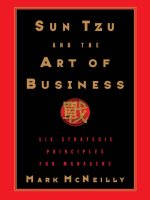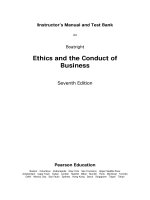Ethics and the conduct of business 8th by john boatright and smith 2017 chapter 12
Bạn đang xem bản rút gọn của tài liệu. Xem và tải ngay bản đầy đủ của tài liệu tại đây (117.1 KB, 19 trang )
Ethics and the Conduct of Business
Eighth edition
Chapter 12
Corporate Social
Responsibility
Copyright © 2017, 2012, 2009 Pearson Education, Inc. All Rights Reserved
Modules
• Introduction: Corporate Social Responsibility
• 12.1: The CSR Debate
• 12.2: Normative Case for CSR
• 12.3: Business Case for CSR
• 12.4: Implementing CSR
• 12.5: Business with a Mission
• 12.6: Case Studies
• Conclusion: Corporate Social Responsibility
Copyright © 2017, 2012, 2009 Pearson Education, Inc. All Rights Reserved
Learning Objectives (1 of 2)
•
•
•
12.1: Recognize the significance and implications of
corporate social responsibility for businesses, how CSR is
commonly demonstrated, and its related concepts
12.2: Describe the dominant moral arguments against the
concept of CSR and the counterarguments and
justifications for CSR as a requirement of companies
12.3: Analyze the arguments that a market for virtue makes
CSR a profitable strategy and a source of competitive
advantage
Copyright © 2017, 2012, 2009 Pearson Education, Inc. All Rights Reserved
Learning Objectives (2 of 2)
•
•
•
12.4: Summarize the important aspects of successful CSR
programs, the difficulties with measuring the social
performance of companies, and various attempts at
measurement
12.5: Compare how nonprofit and for-profit social
enterprises operate and can compete successfully in the
marketplace
12.6: Compare how nonprofit and for-profit social
enterprises operate and can compete successfully in the
marketplace
Copyright © 2017, 2012, 2009 Pearson Education, Inc. All Rights Reserved
Introduction: Corporate Social
Responsibility
• Basis for social responsibility
• Requirements to implement CSR programs
• Benefits of CSR programs
• Social enterprises
Copyright © 2017, 2012, 2009 Pearson Education, Inc. All Rights Reserved
12.1: The CSR Debate (1 of 2)
Objective: Recognize the significance and implications of corporate social responsibility
for businesses, how CSR is commonly demonstrated, and its related concepts
• 12.1.1: Meaning of CSR
– Concept of CSR
Copyright © 2017, 2012, 2009 Pearson Education, Inc. All Rights Reserved
Figure 12.1
Copyright © 2017, 2012, 2009 Pearson Education, Inc. All Rights Reserved
12.1: The CSR Debate (2 of 2)
Objective: Recognize the significance and implications of corporate social responsibility
for businesses, how CSR is commonly demonstrated, and its related concepts
• 12.1.2: Examples of CSR
– General agreements
• 12.1.3: Related Concepts
– Corporate social responsiveness
– Elements of corporate social performance
– Corporate citizens
Copyright © 2017, 2012, 2009 Pearson Education, Inc. All Rights Reserved
12.2: Normative Case for CSR
Objective: Describe the dominant moral arguments against the concept of CSR and the
counterarguments and justifications for CSR as a requirement of companies
• 12.2.1: Classical View
– Expression of classical view
• 12.2.2: Friedman on CSR
– Fiduciary argument
– Taxation argument
Copyright © 2017, 2012, 2009 Pearson Education, Inc. All Rights Reserved
12.3: Business Case for CSR (1 of 2)
Objective: Analyze the arguments that a market for virtue makes CSR a profitable strategy
and a source of competitive advantage
• 12.3.1: The Market for Virtue
– Factors that induce managers to take on CSR activities
– Power of virtue
Copyright © 2017, 2012, 2009 Pearson Education, Inc. All Rights Reserved
Table 12.2: A Watch List of Industries
and Companies
Industries
Issue(s)
Companies
Consumer goods: shoes, apparel, and
household products
Goods are manufactured in contract
factories overseas.
Nike, Gap, Walmart
Petroleum, timber, and mining
Environment issues
Shell, Home Depot, Rio Tinto
Food and beverage
Raw materials are sourced from lessdeveloped countries.
Starbucks, Nestlé, Coca-Cola
Tobacco and fast foods
Tobacco-related deaths and obesity
Altria (Philip Morris), Kraft, McDonald’s
Copyright © 2017, 2012, 2009 Pearson Education, Inc. All Rights Reserved
12.3: Business Case for CSR (2 of 2)
Objective: Analyze the arguments that a market for virtue makes CSR a profitable strategy
and a source of competitive advantage
• 12.3.2: Competitive Advantage
– Strategic CSR
Copyright © 2017, 2012, 2009 Pearson Education, Inc. All Rights Reserved
12.4: Implementing CSR
Objective: Summarize the important aspects of successful CSR programs, the difficulties
with measuring the social performance of companies, and various attempts at
measurement
• 12.4.1: Program Selection and Design
– Guidelines
• 12.4.2: Reporting and Accountability
– Social reporting
Copyright © 2017, 2012, 2009 Pearson Education, Inc. All Rights Reserved
12.5: Business with a Mission
Objective: Compare how nonprofit and for-profit social enterprises operate and can
compete successfully in the marketplace
• 12.5.1: Social Enterprise
– Definition
– Forms
• 12.5.2: Competing Successfully
– Overview
• 12.5.3: Mission and Trust
– For-profit organization
Copyright © 2017, 2012, 2009 Pearson Education, Inc. All Rights Reserved
Table 12.3: Nonprofit versus For-Profit
Social Enterprises
Categories
Nonprofit SE
For-Profit SE
Definition
A nonprofit whose main source of revenue is
earned income, not donations
A business created for a social purpose, that operates in
a socially-beneficial manner
AKA
Enterprising nonprofits, commercial nonprofits
Possible forms:
• subsidiary of a hybrid nonprofit
• benefit corporation (community interest company)
• Certified B Corporation
Example(s)
Benetech (technology to aid global literacy)
Patagonia (environmentally-sustainable clothing)
Toms Shoes (donates shoes to the needy)
Available
funding
Sales, donations, loans
Sales, equity capital, impact investment
Advantages
Tax benefits
Income from donations
People have more confidence in nonprofit causes
Equity capital allows faster growth, more effective use of
resources
Ability to make a profit
Challenges
Need for innovation
Pressure to use donations for given purposes
Limits on spending
Sales, equity capital, impact investment
Need for innovation
Pressure to give some control to outside investors
Difficulty keeping focus on social mission over profit
Loss of public trust
Copyright © 2017, 2012, 2009 Pearson Education, Inc. All Rights Reserved
12.6: Case Studies (1 of 2)
Objective: Compare how nonprofit and for-profit social enterprises operate and can
compete successfully in the marketplace
• 12.6.1: Case: Starbucks and Fair Trade Coffee
–
–
–
–
Mission
Issue
Fair trade coffee
Starbucks response
Copyright © 2017, 2012, 2009 Pearson Education, Inc. All Rights Reserved
Table 12.4: Requirements for Fair Trade
Certification
Condition
Description
Fair prices
Democratically organized farmer groups receive a guaranteed minimum floor price
and an additional premium for certified organic products. Farmer organizations are
also eligible for pre-harvest credit.
Fair labor conditions
Workers on Fair Trade farms enjoy freedom of association, safe working conditions,
and living wages. Forced child labor is strictly prohibited.
Direct trade
Importers purchase from Fair Trade producer groups as directly as possible,
eliminating unnecessary middlemen and empowering farmers to develop the
business capacity necessary to compete in the global marketplace.
Democratic and transparent
organizations
Fair Trade farmers and farmworkers decide democratically how to invest Fair Trade
revenues.
Community development
Fair Trade farmers and farmworkers invest Fair Trade premiums in social and
business development projects such as scholarship programs, quality-improvement
training, and organic certification.
Environmental sustainability
Harmful agrochemicals and GMOs are strictly prohibited in favor of environmentally
sustainable farming methods that protect farmers’ health and preserve valuable
ecosystems for future generations.
Copyright © 2017, 2012, 2009 Pearson Education, Inc. All Rights Reserved
12.6: Case Studies (2 of 2)
Objective: Compare how nonprofit and for-profit social enterprises operate and can
compete successfully in the marketplace
• 12.6.2: Case: Timberland and Community Service
–
–
–
–
Commerce and justice
City Year nonprofit organization
Community service program
Change in economic situation
• 12.6.3: Case: Coca-Cola’s Water Use in India
– Groundwater depletion case
Copyright © 2017, 2012, 2009 Pearson Education, Inc. All Rights Reserved
Conclusion: Corporate Social
Responsibility
• Meaning of CSR
• Arguments for CSR
• Normative case for CSR
• Virtual industry
• Strategic CSR
Copyright © 2017, 2012, 2009 Pearson Education, Inc. All Rights Reserved









